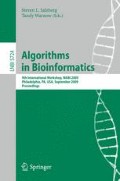Abstract
We develop, analyze and experiment with a new tool, called madmx, which extracts frequent motifs, possibly including don’t care characters, from biological sequences. We introduce density, a simple and flexible measure for bounding the number of don’t cares in a motif, defined as the ratio of solid (i.e., different from don’t care) characters to the total length of the motif. By extracting only maximal dense motifs, madmx reduces the output size and improves performance, while enhancing the quality of the discoveries. The efficiency of our approach relies on a newly defined combining operation, dubbed fusion, which allows for the construction of maximal dense motifs in a bottom-up fashion, while avoiding the generation of nonmaximal ones. We provide experimental evidence of the efficiency and the quality of the motifs returned by madmx.
Access this chapter
Tax calculation will be finalised at checkout
Purchases are for personal use only
Preview
Unable to display preview. Download preview PDF.
References
Agrawal, R., Srikant, R.: Fast algorithms for mining association rules. In: Proc. of 20th VLDB, pp. 487–499 (1994)
Apostolico, A., Comin, M., Parida, L.: VARUN: discovering extensible motifs under saturation constraints. IEEE Trans. on Computational Biology and Bioinformatics (to appear, 2009)
Apostolico, A., Parida, L.: Incremental paradigms of motif discovery. Journal of Computational Biology 11(1), 15–25 (2004)
Apostolico, A., Tagliacollo, C.: Optimal offline extraction of irredundant motif bases. In: Lin, G. (ed.) COCOON 2007. LNCS, vol. 4598, pp. 360–371. Springer, Heidelberg (2007)
Apostolico, A., Tagliacollo, C.: Incremental discovery of the irredundant motif bases for all suffixes of a string in O(n 2 log n) time. Theoretical Computer Science 408(2-3), 106–115 (2008)
Arimura, H., Uno, T.: Mining maximal flexible patterns in a sequence. In: Satoh, K., Inokuchi, A., Nagao, K., Kawamura, T. (eds.) JSAI 2007. LNCS (LNAI), vol. 4914, pp. 307–317. Springer, Heidelberg (2008)
Jurka, J., Kapitonov, V.V., Pavlicek, A., Klonowski, P., Kohani, O., Walichiewicz, J.: Repbase Update, a database of eukaryotic repetitive elements. Cytogenet. Genome Res. 110, 462–467 (2005)
Morris, M., Nicolas, F., Ukkonen, E.: On the complexity of finding gapped motifs. CoRR, abs/0802.0314 (2008)
Parida, L.: Some results on flexible-pattern discovery. In: Giancarlo, R., Sankoff, D. (eds.) CPM 2000. LNCS, vol. 1848, pp. 33–45. Springer, Heidelberg (2000)
Parida, L.: Pattern discovery in bioinformatics. Mathematical and Computational Biology Series. Chapman & Hall / CRC, Boca Raton (2008)
Pisanti, N.: Segment-based distances and similarities in genomic sequences. PhD thesis, University of Pisa, Italy (2002)
Pisanti, N., Crochemore, M., Grossi, R., Sagot, M.F.: Bases of motifs for generating repeated patterns with wild cards. IEEE Trans. on Computational Biology and Bioinformatics 2(1), 40–50 (2005)
Rigoutsos, I., Floratos, A.: Combinatorial pattern discovery in biological sequences: the TEIRESIAS algorithm. Bioinformatics 14(1), 55–67 (1998)
Saha, S., Bridges, S., Magbanua, Z.V., Peterson, D.G.: Empirical comparison of ab initio repeat finding programs. Nucleic Acids Res. 36(7), 2284–2294 (2008)
Smit, A.F.A., Hubley, R., Green, P.: RepeatMasker Open-3.0. 1996–2004, http://www.repeatmasker.org
Ukkonen, E.: Structural analysis of gapped motifs of a string. In: Kučera, L., Kučera, A. (eds.) MFCS 2007. LNCS, vol. 4708, pp. 681–690. Springer, Heidelberg (2007)
Author information
Authors and Affiliations
Editor information
Editors and Affiliations
Rights and permissions
Copyright information
© 2009 Springer-Verlag Berlin Heidelberg
About this paper
Cite this paper
Grossi, R., Pietracaprina, A., Pisanti, N., Pucci, G., Upfal, E., Vandin, F. (2009). MADMX: A Novel Strategy for Maximal Dense Motif Extraction. In: Salzberg, S.L., Warnow, T. (eds) Algorithms in Bioinformatics. WABI 2009. Lecture Notes in Computer Science(), vol 5724. Springer, Berlin, Heidelberg. https://doi.org/10.1007/978-3-642-04241-6_30
Download citation
DOI: https://doi.org/10.1007/978-3-642-04241-6_30
Publisher Name: Springer, Berlin, Heidelberg
Print ISBN: 978-3-642-04240-9
Online ISBN: 978-3-642-04241-6
eBook Packages: Computer ScienceComputer Science (R0)

